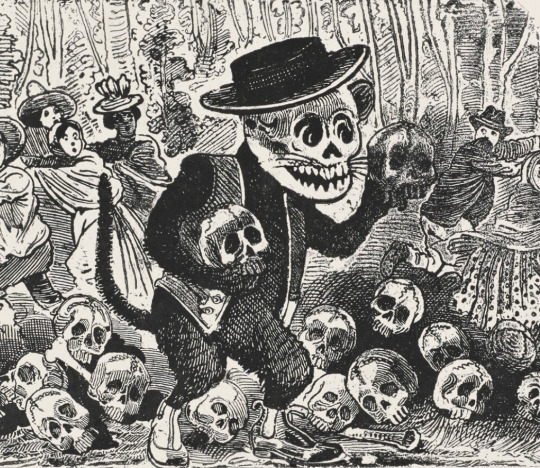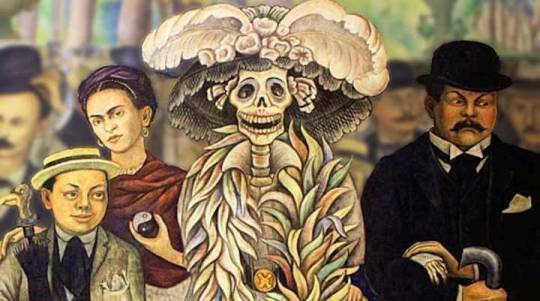#jose guadalupe posadas
Explore tagged Tumblr posts
Text
Top 5 painters/artists
5. Sandro Botticelli: Mainly because The Birth of Venus awoke something within me at age 6.

4. Alphonse Mucha: Yeah, I’m basic. Art Nouveau is pretty and a great source of inspiration.

I just think they’re neat.
3. José Guadalupe Posada: You know this guy, he made La Catrina!

(Yeah, that’s from him, he wasn’t the first one to draw funky Mexican skeletons, but he made the most representative one. This is why I find it so odd whenever I see someone claiming that painting your face as a Catrina is “cultural appropriation” since it has nothing to do with our “ancient traditions”). He made his lithographies for newspapers and popular publications. His art is a showcase of Mexican daily life during the Turn of the century.

(This is from an article about an “scandalous” ball held by gay men, half of them in drag, a very influential event in Mexican LGBT history.) Also, more funky skeletons:



2.Remedios Varo: A Spanish surrealist painter who later migrated to Mexico. Her paintings are full of symbolism and they have an overall cool aesthetic.


1.Francisco de Goya: You know…



All his art is very expressive. The themes of his paintings go from the Spanish Royal family to the Spanish daily life and the Horrors of War.



My favorites are the Caprichos. They can be pretty scary. Here, have some monsters and witches.


17 notes
·
View notes
Text

Here's another unusual print we found while perusing through the more than 500 free images by José Guadalupe Posada on JSTOR. It depicts a party in 1901 in which men in drag danced with men in suits. While this was surely not intended as a celebratory image originally, we're making it one now because we love knowing that these parties were happening in Mexico more than 100 years ago!
This particular example comes from the Metropolitan Museum of Art collection on JSTOR, which features more than 1/2 million open access images.
#drag#gay history#jose guadalupe posada#posada#prints#printmaking#mexican art#illustration#open access#research#jstor
2K notes
·
View notes
Text

Beautiful cat calavera by José Guadalupe Posada. Source.
411 notes
·
View notes
Text

Ballad of the Snail (Corrido del Caracol), ca. 1899, by José Guadalupe Posada
+
34 notes
·
View notes
Text

Halloween Thrawn.
#thrawn#star wars#i based his disguise on an illustration by jose guadalupe posada#because he is so iconic for this season#i also wanted to draw eli and karin#but i had to help my mom setting the altar for dia de muertos#this is part of my great planing
80 notes
·
View notes
Text

"Calavera of the Alley Cat"
engraving
José Guadalupe Posada (1852–1913)
#art#artwork#esoteric#esoteric art#esoteric artwork#occult#occult art#occult artwork#dark art#dark artwork#calavera#engraving#jose guadalupe posada
126 notes
·
View notes
Photo

I get the appeal of Van Gogh’s “Skeleton Smoking a Cigarette” but have you seen José Guadalupe Posada’s “Skull with a Beard”
103 notes
·
View notes
Text

A Witch Carrying a Child on Her Broom, Jose Guadalupe Posada, 1880-1910
From the Met Museum
#a witch carrying a child on her broom#Jose guadalupe posada#1880#1880s#1890s#1900s#1910s#1910#1800s#19th century#20th century#print#art
3 notes
·
View notes
Text

St George by Jose Guadalupe Posada
19 notes
·
View notes
Text


José Guadalupe Posada, Collision Between Streetcar and a Hearse
and from the intro to Joseph Mitchell’s Up In The Old Hotel
26 notes
·
View notes
Text

Feliz Dia de los Muertos!
Dressing up for Dia de los Muertos is a popular tradition in the USA and Mexico. People of all ages and genders wear skeletal makeup with flower crowns or other headdresses along with traditional Mexican clothing or clothing inspired by Pre Columbian cultures at Dia de los Muertos festivals. This is a way of honouring ancestors and celebrating Mexican culture. If the outfits are worn with the correct intentions of celebrating Dia de los Muertos and with an understanding of the cultural significance of the costumes and makeup, it is a tradition anyone can take part in.
My digital self portrait shows me dressed as the character La Calavera Catrina. La Calavera Catrina is the iconic skeleton lady of Dia de los Muertos created by Mexican artist Jose Guadalupe Posada in 1910. This is a photo of me with a digital skull makeup filter in front of an ofrenda image created with AI art. The flower crowns and other sparkling details were created using Picmix GIF maker.
I wish everyone celebrating today a safe, joyful, and contemplative Dia de los Muertos!
#DiaDeLosMuertos
#dia de los muertos#la catrina#calavera#jose guadalupe posada#ofrenda#flower crown#skull makeup#digital art#picmix#ai artwork#mexican culture#animated gif#self portrait
12 notes
·
View notes
Text

José Guadalupe Posada was a popular Mexican printmaker now mostly remembered for his satirical calaveras (skeletons), but we love this awesome rooster from the Open Metropolitan Museum of Art collection on JSTOR!
If you want to see more of his work, including his many calaveras, demons, and drunks (warning, much of it features graphic violence!), you can find more than 500 free images on JSTOR.
#jose guadalupe posada#posada#prints#printmaking#mexican art#illustration#rooster#animal art#open access#research#jstor
440 notes
·
View notes
Text






Book 519
J.G. Posada: Messenger of Mortality
Julian Rothenstein, ed.
Moyer Bell Limited 1989
I think José Guadalupe Posada (1852-1913) may be one of my favorite artists. His work speaks to so many aspects of my own personality—satirical, humorous, populist, absurd, and with a great appreciation for the morbid. So, I think it’s a bit of a crime that there aren’t more books of his work published in this country. It is estimated that over the course of his career he produced over 20,000 images, but, despite that, he died penniless and forgotten. However, it wouldn’t be long after his passing that he would be rediscovered and studied by such artists as Rivera and Kahlo, and then by Europeans such as Eisenstein and the French surrealists. Posada saw and memorialized life as it happened around him—the working people, riots, natural disasters, suicides, murders, and crimes—but it is his calaveras, the skulls used to commemorate the Day of the Dead, which he used to expose hypocrisy and reveal the ultimate absurdity of humanity, that he is best remembered.
#bookshelf#library#personal collection#personal library#books#bibliophile#book lover#illustrated book#booklr#graphic design#Jose Guadalupe posada#messenger of mortality#julian rothenstein#art#moyer bell
3 notes
·
View notes
Text

Los esqueletos de Jose Guadalupe Posada.
8 notes
·
View notes
Text
¿SABÍAS QUE LOS MEXICAS NO SE DISFRAZABAN DE CATRINAS?
Los mexicas NO se pintaban los rostros de calaveras ni se disfrazaban de catrinas.
“La Catrina” no proviene de los mexicas. Es una sátira creada por el caricaturista José Guadalupe Posada que en tiempos del juarismo y el porfiriato se burlaba de los mestizos e indígenas que iban subiendo de nivel económico y pretendía ser europeos y renegaban de su propia raza, herencia y cultura. Se les llamaba los “garbanceros”, precisamente por dedicarse al cultivo y venta de garbanzos.
Entonces José Guadalupe Posada, creó “La Calavera Garbancera” para expresar que los garbanceros andaban «...en los huesos, pero con sombrero francés con sus plumas de avestruz».
Diego Rivera la nombró “La Catrina”, de la palabra “catrín”, que definía (a veces de forma despectiva) a la clase social alta, y la eternizó en su mural “Sueño de una tarde dominical en la Alameda Central”, (la calavera con su estola de plumas aparece junto a José Guadalupe Posada, Diego Rivera como niño y Frida Kahlo).
Imagen: mural “Sueño de una tarde dominical en la Alameda Central”, de Diego Rivera.

#mexico#dia de muertos#catrina#jose guadalupe posada#diego rivera#sueño de una tarde dominical en la Alameda Central
12 notes
·
View notes
Text
Celebrating the Day of the Dead: A Rich and Colorful Tradition
In our latest blog post, we delve into the vibrant and colorful traditions of the Day of the Dead celebration. Known as Día de los Muertos, this annual Mexican holiday is a time for families to honor and remember loved ones who have passed away.
The Day of the Dead, also known as Dia de Los Muertos, is a vibrant and unique holiday. It is commonly celebrated in Mexico and other Latin American countries. Despite its name, the holiday is not a day of mourning. The Day is a joyful commemoration of loved ones who have passed away. With its colorful decorations, lively festivities and deep cultural significance, the Day of the Dead is a truly…
#A Few of my Favorite Things#Altars#Calavera#Day of the Dead#Dia de Los Muertos#Jose Guadalupe Posada#La Catrina#Marigolds#New Blog Post#Ofrendas#Pan de Muerto#Sugar Skull#Wonderlesch
0 notes